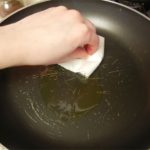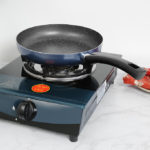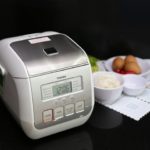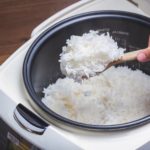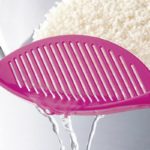Boil rice directly in the pot
To increase convenience, many people have the habit of boiling rice directly in the pot of an electric rice cooker and believe that this is a harmless action. However, whether the pot has a non-stick coating or not, the manufacturers have a protective layer on the surface of the pot to ensure safe cooking for users.
Therefore, boiling rice directly in the pot can easily scratch the protective surface, not only reducing the aesthetics of the electric rice cooker but also making it unsafe for cooking, especially with non-stick pots. The best advice is to boil rice using a sieve or a small bowl, then pour the rice into the electric rice cooker and add water before cooking.
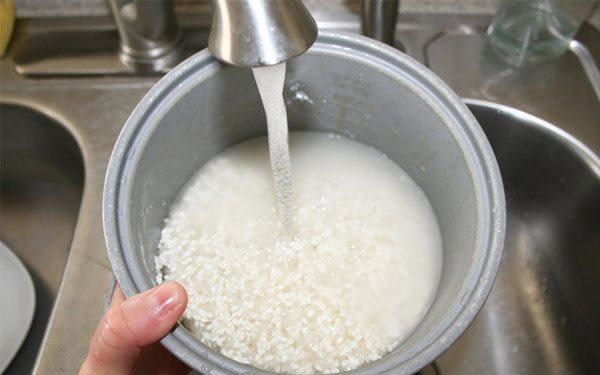
Do not wipe the pot dry before cooking
This action indirectly damages the heat retention properties of the electric rice cooker because water can cause corrosion or make the pot and the bottom heating plate turn black, leading to a decrease in aesthetics and an increased risk of electric leakage, reducing the durability of the cooker.
Users should always remember to wipe the exterior of the electric rice cooker dry before cooking to ensure the safety and durability of their rice cooker.
Place the pot in the cooker with one hand
With the concave design of the inner pot of an electric rice cooker, placing it into the cooker with one hand can cause uneven contact with the heating plate, resulting in unevenly cooked rice. Moreover, this action can also damage the heat retention properties of the inner pot, making the electric rice cooker operate unstably.
Gently place the inner pot into the cooker with both hands, rotate it half a turn left/right to ensure even contact with the heating plate for perfectly cooked rice.
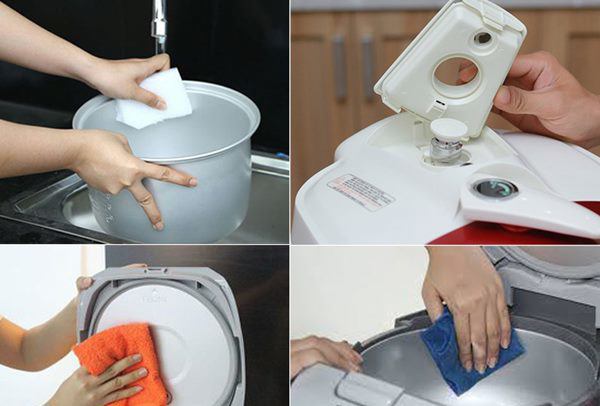
Press the “Cook” button multiple times
When you want to continuously reheat rice, create crispy rice, or when braising/stewing/making cakes with an electric rice cooker, pressing the “Cook” button multiple times to adjust the heat level… This can easily cause the heating plate of the electric rice cooker to jump too soon (undercooked rice) or too late (burnt rice).
It is best to minimize pressing the “Cook” button multiple times when using an electric rice cooker.
Using the wrong function of the electric rice cooker
If it is not a multifunctional electronic rice cooker, conventional electric rice cookers are mainly used for cooking and reheating rice, some may also have functions for cooking porridge/steaming vegetables or making cakes.
Therefore, many users tend to utilize their conventional electric rice cookers to braise, stew, or make some cakes that require high heat settings, causing them to press the “Cook” button on the electric rice cooker multiple times. As mentioned, this action will eventually wear out the heating plate and is the reason why rice ends up undercooked or overcooked.
It is advisable to use the correct function of the electric rice cooker for it to operate reliably and safely. If you have diverse and frequent cooking needs, you can consider equipping yourself with a multifunctional electronic rice cooker that offers many convenient and delicious cooking options.
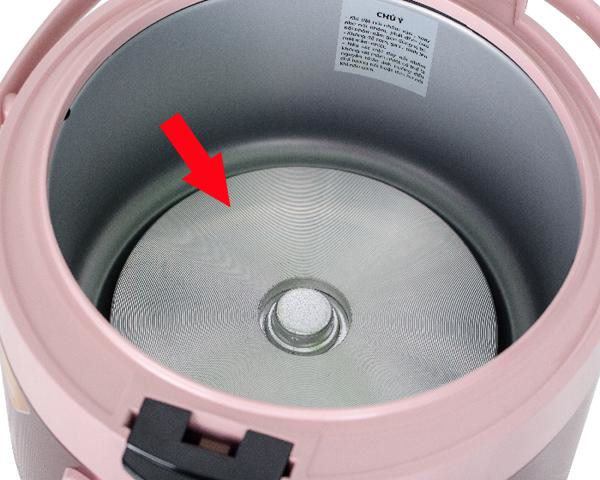
Using the same power outlet as high-powered electrical appliances
Microwaves, ovens… high-powered electrical appliances need separate power outlets to ensure electrical safety.
An electric rice cooker also needs its own separate power outlet from these devices to avoid the risk of short circuits, unstable voltage, and potential impacts on the shared power source.
Using metallic rice scoops
They can scratch the non-stick coating of the electric rice cooker. It is recommended to use wooden or plastic spoons and rice scoops to protect the surface of the electric rice cooker.
Cleaning the pot when it is still hot
Sometimes, users unintentionally soak the inner pot of the electric rice cooker in water while it is still hot immediately after finishing the rice or after using the pot for braising or stewing to ease the cleaning process.
This action can cause damage to pots with non-stick coatings because it creates a thermal shock, which can easily cause the non-stick coating to peel off or become damaged. In that case, the electric rice cooker will no longer be safe for cooking.
It is best to let the pot cool completely before cleaning. If worried about hard-to-clean food stains or burnt rice, you can soak the pot in warm water and dishwashing liquid to soften the dirt before cleaning.
Not cleaning the electric rice cooker regularly and properly
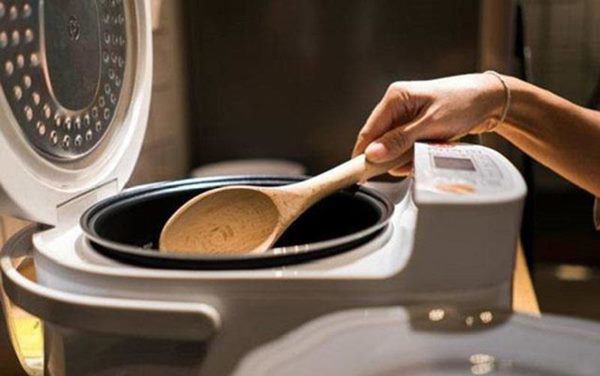
Cleaning the electric rice cooker is not just about cleaning the inner pot but also wiping the exterior of the cooker, cleaning the inner lid, the steam vent, and the excess water tray (which can develop mold or cause unpleasant odors to affect the rice).
Also, cleaning the inside of the cooker to remove food residue, grease, and dirt that may fall or accumulate inside, including around the heat retention plate and the gaps in the bottom of the cooker.
Many users do not pay attention and only clean the inner pot after use. When an electric rice cooker is not thoroughly cleaned, it not only reduces its freshness but also affects the quality and taste of the cooked rice.
When cleaning, it is best to use a soft brush or sponge without any metal components, even when cleaning a non-stick pot, to protect the shiny surface of the pot, prevent scratches, and ensure safe cooking.
According to Phụ nữ Việt Nam
Transforming a Regular and Old Pan into Non-Stick Cookware
Learn how to transform your regular and old non-stick pans into fresh, new non-stick ones with a few easy steps. With this cost-effective kitchen makeover, you can enjoy all the amazing benefits of a non-stick cooking experience without the need to purchase new pans.
Tips for Proper Care of an Electric Rice Cooker
For unbeatable prices and outstanding customer service, is the perfect destination for finding electronic and home appliances. With a wide selection of high-end smartphones and everyday household items, customers can find exactly what they need. Plus, special discounts and promotions are always available for customers to take advantage of. has been the go-to shop for all your electronic and home appliance needs since its inception and is here to stay!
How to Clean a Rice Cooker Thoroughly
Keeping your electric rice cooker in top shape and ensuring its longevity can be easily achieved by learning how to clean it properly. Get the most out of your appliance with helpful tips from Ði?n Máy XANH’s latest article on cleaning electric rice cookers!
























